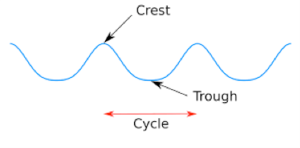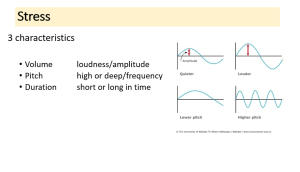7 Lesson 7: How is Language Physical? (has activity, but spacing is clunky!)
Syllables, and Stress, and Sounds, Oh My!
Sound is made of energy. That energy travels in waves. How high a wave is (amplitude) determines is volume. How long a wave is (frequency) determines its pitch. Shorter waves have higher pitch. Longer waves have lower pitch.

Stress is realized on syllables.

Syllables have a structure. (content under construction).
Learn More: Watch Lecture Sound, and Syllables, and Stress!
Activity 1: Phonetics—Identifying, Describing, Transcribing, and Analyzing
Purpose:
- To practice describing and transcribing sounds using IPA
- To practice identifying syllable structures in words.
Set 1: Identifying and Describing Sounds
- (a) Identify the IPA symbol that represents the sound bolded in each word below. (b) Describe the bolded sound in each of the words.
- close
- glottal
- laryngeal
- affricate
- interdental
- fricative
- plosive
- manner
- high
- velar
Bonus!
- alve_olar
- approximant
Set 2: Transcriptions!
Write an example of an English word that meets the criteria below.
- (a) Provide an orthographic representation (English spelling), and (b) an IPA transcription of the word.
- Ends with a labio-dental consonant.
- Ends with a bilabial consonant.
- Ends with an alveolar consonant.
- Begins with an interdental consonant.
- Begins with a velar consonant.
- End with an oral plosive.
- Begin with a nasal plosive.
- End with an velar nasal.
- Contain an approximant in the middle of the word.
- Contains a close front unround vowel.
Set 3: Syllables and Stress
- a) Divide these words into syllables (remember the onset maximalization principle) and indicate where the stress is. Think about sounds, not letters. Use linguistic notations.
- b) Next to the word, indicate the Consonant/Vowel structure of the syllable using CVC notation.
- Fricative
- Consonant
- Linguistics
- Transcription
- Plosive
Activity 2! Indonesian Reduplication
Purposes:
· To practice analyzing (breaking down into its parts) syllable structures of words. (CO3c)
· To practice identifying which parts of syllables are duplicated in a specific language. (CO3c)
· To introduce morphology! (CO3h)
· To introduce linguistic interlinear gloss abbreviations. (CO2e)
· To introduce the concept of linguistic diversity. (CO1a)
· To practice articulating a reasoned framework for drawing conclusions. (CO4b, GEOv and vi.)
About Indonesian:
Malay and Indonesian refer to a group of languages spoken in Melanesia and South Asia.
Indonesian is a branch of the Austronesian language family. The term ‘Indonesian’ also refers to the standardized variety of Malay, one of the Indonesian languages spoken throughout Melanesia as a lingua franca. One of the Malay languages is Palembang. Palembang is spoken in South Sumatra. Much of the data below comes from Palembang, the rest from standardized Indonesian (Bahasa Indonesian). Indonesian languages are spoken by about 260 million people and the language family is healthy (Ethnologue 2024). Sources for the data are listed in the references below.
Indonesian languages use alphabets. Several of those alphabets are written using one of those curly scripts we discussed in week 2. Here is what a word in Javanese looks like when written their alphabet: . This word means ‘Javanese’. The data below are presented in IPA; the question mark is used to indicate glottal stop, for ease of transcription.
About reduplication:
Reduplication is a process of word building (morphology) in which a word, or part of a word is duplicated to change the meaning of the word.
The Data:
Set A: Full Reduplication
Nouns
1)
gula ‘sugar’ gulagula ‘sweets’
laki ‘husband’ lakilaki ‘man’
orang ‘human’ orangorang ‘people’
anak ‘child’ anakanak ‘children’
bangunan ‘building’ bangunanbangunan ‘buildings’
Susu ‘milk’ susususu ‘containers of milk’
bras ‘rice’ brasbras ‘containers of rice’
2)
langit ‘sky’ langitlangit ‘ceiling’
diam ‘quiet’ diamdiam ‘silence’
mata ‘eye’ matamata ‘spy’
lanang ‘boy’ lananglanang ‘only the boy’
Adjectives
kecil ‘small’ kecilkecil ‘very small’
sungguh ‘sincere’ sungguhsungguh ‘sincerely’
Verbs
1)
duduk ‘sit’ dudukduduk ‘sit around’
berjalan ‘walk’ berjalanjalan ‘stroll’
melihat ‘see’ melihatlihat ‘browse’
membuku ‘open’ menbukubuku ‘leaf through (a book)’
ujan ‘to rain’ ujanujan ‘to be raining’
2)
shou ‘talk’ shoushou ‘say a little’
jingu? ‘look’ jingu?jingu? ‘glance’
Set B: Imitative Reduplication (Palembang)
garut ‘scratch’ garutmarut ‘scratch each other’
pukul ‘hit’ pukulmukul ‘hit each other’
sayur ‘vegetable’ sayurmayur ‘all sorts of vegetables’
ceghai ‘separate’ ceghai-beghai ‘divorce’
selu? ‘details’ selu?belu? ‘all kinds of details’
lau? ‘meat and vegetables’ lau?pau? ‘all kinds of meat and vegetables’
Set C: (Palambang)
1)
kerlap ‘light’ kerlap-kerlip ‘twinkling’
serba ‘all around’ serba-serbi ‘various’
tindak ‘follow’ tindak-tanduk ‘attitude’
2)
balik ‘return home’ bulak-balik ‘go back and forth’
jingu? ‘look’ jinga?-jingu? ‘look at each other’
Set D:
1)
tangga ‘stair’ tetangga ‘neighbor’
sepuh ‘elder’ sesepuh ‘elders’
2)
laki ‘husband’ lelaki ‘male’
(Pelambang)
koyak ‘tear’ kokoyak ‘frayed’
siap ‘ready’ sisiap ‘everything ready
The Questions:
Using the data above, answer these questions:
1. Set A of the data above shows full reduplication. The entire word is duplicated. What do you notice about how the meaning changes from the base form to the reduplicated word?
2. What is the difference between the changes in meaning from the subsets 1) and 2) in nouns and verbs in data Set A?
3. Set B is similar to set A, but instead of reduplicating the entire word, only part of the word is duplicated. What part of the word is duplicated?
4. In Set B, one part of the word, part of the first syllable of the word, does not get duplicated, but it gets changed. Thinking about syllable structure, which part of that syllable gets changes in the duplicated form?
5. In Set C (1), the whole word is duplicated, but one part of the word changes. Thinking about syllable structure, which part of the word changes (which syllable) and which part of the syllable changes?
6. Set C (2) is similar to set C (1), with one small change. Using syllable structure terminology, describe that change.
7. What the heck is going on in Set D? It is different from all the others. Using syllable structure terminology, describe how set D reduplication works.
8. If set A is called ‘full reduplication’ and set B is called ‘imitative’ reduplication, what would you name sets C and D?
Part II.
More Data: English Reduplication
Set A:
Ding-dong
Nick-nack
Sing-song
Wishy-washy
Zig-zag
Set B:
Bye-bye
Dum-dum
Goody-goody
Wee-wee
Yo-yo
Set C:
Down-town
Hanky-panky
Hocus-pocus
Hurly-burly
Roly-poly
Walkie-talkie
The Questions:
- Which Indonesian reduplication set does each of the above English reduplication sets match? List the matching sets.
- How do you know? Write up a short explanation of how you can tell which set matches which. Don’t forget this part! It supports our Gen Ed 7 critical thinking skill—articulate reasoning.
References:
Alsamadani, M. & Taibah, S. (2019). Types and Functions of Reduplication in Palmbang. Journal of the Southeast Asian Lingusitics Society 12(1).
Habibi, A. W. (2021). The Comparative Study of Reduplication Between English and Indonesian. Universitas Islam Darul ‘Ulum Lamongan 6 (1).
Javanese script. (2024). Wikipedia. https://en.wikipedia.org/wiki/Javanese_script
Indonesian. (2024). Ethnologue. https://www.ethnologue.com/language/ind/
Rafi’ie, M. Pastika, W. & Malini, N. L. N. S. (2018). Types of Indonesian Reduplication as the Translation Equivalence of English Lexicons. Linguistika 48(25).https://media.neliti.com/media/publications/229786-types-of-indonesian-reduplication-as-the-b83593a3.pdf
Sanchez, N. & Stevens, A. M. (1992). Reduplication and affixation in Indonesian. Sealang.net
Taibah, S. (2019). An Overview of Reduplication in Malayic Languages. Semantic Scholar. https://www.semanticscholar.org/paper/An-Overview-of-Reduplication-in-Malayic-Languages-Taibah/b37638a25af21b695b6d7a6b52a27104ef0fdef7